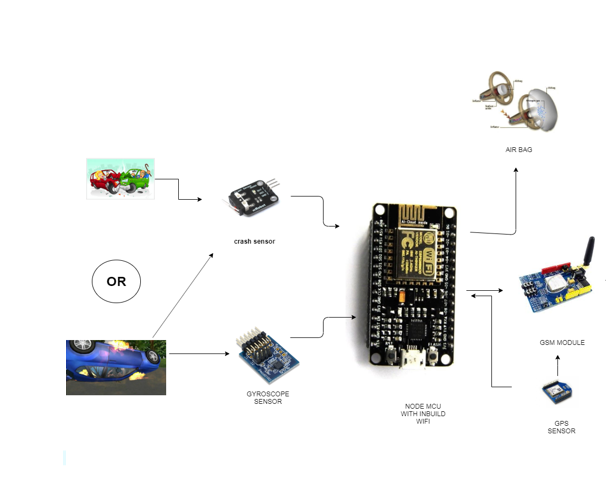Problem Description
Due to high demand for automobiles, there is an increase in traffic hazards and road accidents. An easy to install, accurate and user-friendly solution would be required to send an alert message in real time to the nearest service and rescue center.
Challenge
An alert message in Real Time and Accurate location are crucial in achieving the ultimate aim of faster recovery, quick medical first-aid at accident location (often referred to “The Golden Hour”) and saving lives.
Solution – Brief Description:
The proposed solution is to develop “Vehicle Crash Detection System using IoT”.
Objective:
- Immediate alert message to the nearest hospital or the medical response team.
- Immediate alert message to the closest vehicle recovery team.
- Immediate alert message to the local police / highway patrol with relevant details.
- Accurate location identification (GPS).
- User-friendly system based on IoT.
- Easy to install system with minimal maintenance requirement.
Concept:
The first step is to determine the magnitude, scope and characteristics of the problem.
1. Detecting the vibration of the collision using a “Crash Sensor”
- Crash sensors collect the data necessary to make decisions about air bag deployment.
- Severe or panic braking alone cannot cause an air bag to deploy; air bags deploy only in crashes.
- Crash sensors measure how quickly a vehicle slows down in a frontal crash or accelerates to the side in a side-impact crash.
2. The axial position of the crashed vehicle is detected using a “GYRO SESNOR”.
- A Gyro Sensor sense the rotational motion and changes in orientation.
- Vehicles equipped with Gyro Sensor combined with Crash Sensor can detect the onset of a rollover crash.
3. Detect the location of crash using “GPS Sensor”.
- GPS sensors are receivers with antennas that use a satellite-based navigation system with a network of 30 satellites in orbit around the earth to provide position, velocity and timing information.
- The Indian Regional Navigation Satellite System (IRNSS), with an operational name of NavIC, is an autonomous regional satellite navigation system, that provides accurate real-time positioning and timing services. It covers India and a region extending 1500km around it.
4.Communicate with the rescue and recovery services using “GSM Module”
- A Global System of Mobile Communication module is a chip or circuit that will be used to establish communication between a mobile device or a computing machine and a GSM.
5. Node MCU (Micro Controller)
- NodeMCU includes firmware that runs on open source IoT platform.
- The prototyping hardware typically used is a circuit board functioning as a dual in-line package which integrates a USB controller with a smaller surface mounted board containing the MCU and antenna

Risk and Mitigation Plan:
Research has identified a number of risk factors for road injuries. Movement of people and goods on the road is necessary for social, economic and political reasons. It may not be possible in practice to completely eliminate all risk, but it is possible to reduce exposure to the risk of severe injury and to minimize its intensity and consequences.
Risk factors involving post-crash outcome of injuries:
- Delay in detecting crash to those injured to a health facility
- Leakage of hazardous materials
- Difficulty in rescuing and extracting people from Vehicles.
- Lack of pre-hospitality care.
- Difficulty in evacuating people from buses and coaches involved in crash
Mitigation
- Identify the hazard by carrying out a workplace risk assessment.
- Evaluating the risk of accidents.
- To inform Highway Patrol through GSM module.
Outcome / Conclusion:
The goal of any first responder should be assessment of the situation and reaction to the circumstances with predetermined goals of preventing further injury to persons and/or damage to property. In many circumstances contacting local emergency response services is an appropriate first response. This is necessary when life and serious injury are threatened as well as when fire or imminent danger is present.
Quick accident response aims to reduce, or avoid the potential losses from accident, assure prompt and appropriate assistance to victims of severe accident, and achieve rapid and effective recovery.
Our proposed solution achieves all of the above in a very low-cost model, easy to retrofit / install, extremely user-friendly and accurate, real-time communication.
Source Code:
